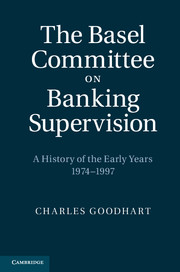Book contents
- Frontmatter
- Contents
- Figures
- Tables
- Foreword
- Preface
- 1 Introduction
- 2 The antecedents of the BCBS
- 3 Modus operandi
- 4 The Concordat
- 5 External and foreign exchange issues
- 6 Capital adequacy and the Basel Accord of 1988
- 7 The Market Risk Amendment
- 8 The Core Principles of Banking Supervision
- 9 Liquidity
- 10 Off-balance-sheet exposures and derivatives
- 11 Other topics addressed by the BCBS
- 12 The relationship of the BCBS with banks and other banking regulators
- 13 Relationships with other non-bank oversight and supervisory bodies
- 14 The legal position of the BCBS
- 15 The international relations of the BCBS
- 16 The BCBS and the social sciences
- 17 Epilogue
- Bibliography
- Index
9 - Liquidity
Published online by Cambridge University Press: 07 September 2011
- Frontmatter
- Contents
- Figures
- Tables
- Foreword
- Preface
- 1 Introduction
- 2 The antecedents of the BCBS
- 3 Modus operandi
- 4 The Concordat
- 5 External and foreign exchange issues
- 6 Capital adequacy and the Basel Accord of 1988
- 7 The Market Risk Amendment
- 8 The Core Principles of Banking Supervision
- 9 Liquidity
- 10 Off-balance-sheet exposures and derivatives
- 11 Other topics addressed by the BCBS
- 12 The relationship of the BCBS with banks and other banking regulators
- 13 Relationships with other non-bank oversight and supervisory bodies
- 14 The legal position of the BCBS
- 15 The international relations of the BCBS
- 16 The BCBS and the social sciences
- 17 Epilogue
- Bibliography
- Index
Summary
George Blunden, the first Chairman of the BCBS, opened its initial meeting (6–7 February 1975) ‘by outlining what he saw as the mandate which the Governors had given the Committee’ (BS/75/1). In this respect, ‘the Committee’s main objective was to help ensure bank solvency and liquidity.’ So, from the outset, the BCBS appreciated that solvency and liquidity were interrelated; both were essential for the stability and survival of a banking system. An illiquid bank (system) would not remain solvent for long, nor would an insolvent bank (system) remain liquid.
The BCBS’ first approach to both solvency and liquidity was in Muller’s paper outlining ‘Responsibility for supervision of banks’ overseas branches, subsidiaries and joint ventures’ (BS/75/5). This paper formed the basis for the Concordat, covering the question of which authorities (who) should be responsible for supervisory oversight, rather than what principles (or numerical ratios) should be applied. This ‘who’ issue has been already reviewed in Chapter 4 on the Concordat, and need not be rehearsed again here, except to remind that, as Muller himself stated (BS/75/5):
a distinction should be made between solvency and liquidity control. The latter should probably be the responsibility of the host authorities, since only those who were familiar with local market conditions and discount facilities could adequately judge the liquidity position of banks operating on their territory (BS/75/5, p. 10).
Information
- Type
- Chapter
- Information
- The Basel Committee on Banking SupervisionA History of the Early Years 1974–1997, pp. 317 - 350Publisher: Cambridge University PressPrint publication year: 2011
